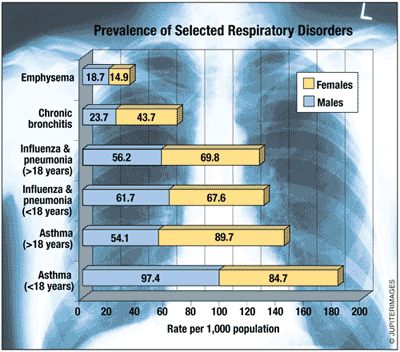US Pharm. 2009;34(7):13.
According to the 2007 National Health Interview Survey (NHIS), 2% of adults have ever been diagnosed with emphysema; 11%, with asthma; and 3%, with chronic bronchitis (CB). Women are more likely to be diagnosed with asthma or CB, and men are more likely to be diagnosed with emphysema. Hispanic adults have lower rates of asthma than non-Hispanic white adults, and lower rates of CB than non-Hispanic white adults or black adults. Adults with at least a bachelor's degree are less likely to be diagnosed with emphysema or CB compared with adults with less education. Adults in poor families have higher percentages of emphysema, asthma, and CB than those in families that are better off. Among adults under the age of 65, those who are insured by Medicaid have higher percentages of emphysema, asthma, and CB than those with private insurance or without insurance.

Asthma: Of the 23 million Americans with asthma, 12.4 million--including 4.1 million under the age of 18--have had an asthma attack. Seven percent (16.2 million) of noninstitutionalized adults and 9% (6.7 million) of children still have asthma, according to the 2007 NHIS. Compared with children in excellent or very good health, those in fair or poor health are 3.5 times as likely to have ever been diagnosed with asthma (41% vs. 11%, respectively) and 5.5 times as likely to still have asthma (41% vs. 7%). Children in poor families are more likely to have ever been diagnosed with asthma (17%) or still have asthma (12%) than children in better-off families (12% and 8%, respectively).
Chronic Bronchitis: Annually, 9 million Americans (3 million males, 6 million females) are diagnosed with CB. This disease is more common in individuals over the age of 45. Females are more than twice as likely to be diagnosed with CB. The number of noninstitutionalized adults with diagnosed CB is 7.6 million (3.4%).
Emphysema: More than 3 million Americans, 91% of them over the age of 45, have been diagnosed with emphysema. The prevalence rate is 52% higher in males. The number of noninstitutionalized adults who have ever been diagnosed with emphysema is 3.7 million (1.7%).
Attempts to Reduce Disparities: Research initiatives are underway to better understand the causes of persistent asthma disparities among different populations. Ways to overcome the barriers to quality asthma care encountered by minority populations and those who live in poverty also are being investigated. Such efforts need to continue in order to reduce the disparities that exist for all respiratory diseases.
To comment on this article, contact rdavidson@jobson.com.






